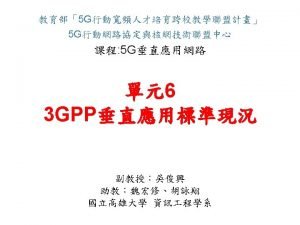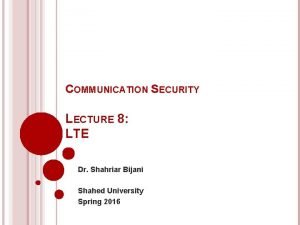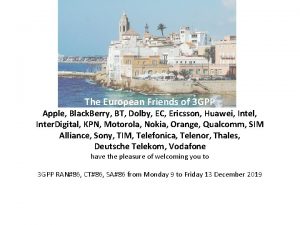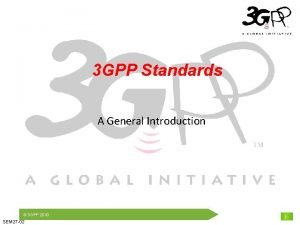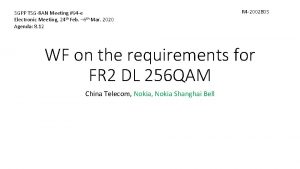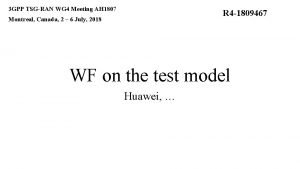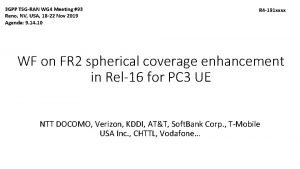3 GPP TSGRAN WG 4 Meeting 96 e





- Slides: 5

3 GPP TSG-RAN WG 4 Meeting # 96 -e Online Meeting, Aug 2020 R 4 -201 xxxx WF on UE RF requirement for 47 GHz band Qualcomm Incorporated

Background • Initial discussions in RAN 4 are captured in R 4 -2011568 • Topics covered by this WF are: Status summary Sub-topic#4 -1 Coex It looks now only one company is supporting a new coexistence simulation with the updated BS parameters. Following the majority view, is it sim acceptable to conclude ACLR/ACS in the previous agreement (LS to WP 5 D) unless further justification to update BS parameters is provided? In other word, can we agree that ACLR is 16 d. B and ACS is 22 d. B for n 262? Sub-topic#4 -2 Max power . (EIRP EIS, spherical coverage and MBR not handled in this WF) MPR: Majority view is that existing MPR can be reused. One company commented it needs further study. Further analysis is encouraged for the next meeting. Sub-topic#4 -3 NS and A-MPR Sub-topic#4 -4 Other Tx Tentative agreements: A-MPR study is not needed until specific regulatory requirement is identified. Sub-topic#4 -6 Other Rx Huawei proposes to study min output power for n 262. To be further discussed. No other Tx requirement has so far been found band specific to n 262. No objection to reuse existing IBB requirement is made. No other Rx requirement has so far been found band specific to n 262. Tentative agreements: IBB requirement is reused from n 259/n 260. Sub-topic#4 -7 BC Many UE vendors propose that BC tolerance should be studied for n 262. Further analysis is encouraged for the next meeting. Sub-topic#4 -9 CA Also See #4 -2. Further checking is needed. It is possible that UL CA is discussed later if some issues are identified. Sub-topic#4 -10 UL Further checking is needed. MIMO 2

WF - 1 • Co-ex requirements for 47 GHz band can be extended from study results for n 260 • • ACLR is 16 d. B (6. 5. 2. 3) ACS and IBB interferers are +22 d. B relative to wanted signal (7. 5 and 7. 6) Co-ex emissions requirements in other bands are FFS (6. 5. 3. 1) NS definition and AMPR study shall be motivated by regulatory requirement identified in contributions • Companies are encouraged to bring analysis and proposals for: • PC 3 UEs: DEIRP analysis corresponding to beam. Correspondence. Without. ULBeam. Sweeping = 0 in table 6. 6. 4. 2 -1 3

WF - 2 • MPR values shall might be revisited if motivated by there is justification for considerations unique specific to 47 GHz • Companies are encouraged to share views on the following items: • • min. output power requirement UL CA requirements UL MIMO requirements Intra-band CA configurations (both uplink and downlink, such as bandwidth class, bandwidth combination sets). Frequency spread ‘FSp’: frequency spectrum from the lowest edge of the lowest configured CC to the upper edge of the highest configured CC in bidirectional spectrum. FSp is a generalized term to cover = frequency separation, for NC CA = aggregated chan. BW, for contiguous CA 4

WF - 3 • According to the footnote NG 65 in the FCC table of frequency allocations, “The Commission reserves the right to monitor developments and to undertake further action concerning interference between Upper Microwave Flexible Use Service and Fixed-Satellite Service, including aggregate interference to satellite receivers, if appropriate” • Whether a “placeholder NS value, ” which is applicable to the US region and maps to the general requirements without any A-MPR, is a feasible way to “future-proof” the band n 262 requirements is FFS and should be resolved next meeting • If, in the future, the FCC does introduce limits which require A-MPR, then this NS value can be repurposed 5


